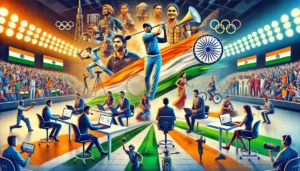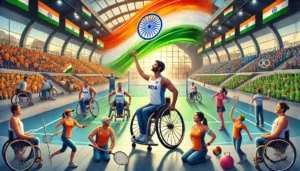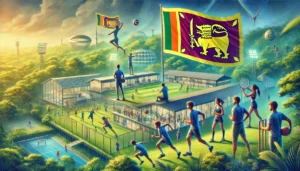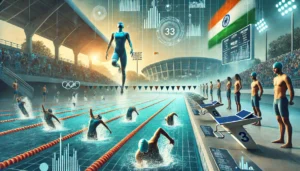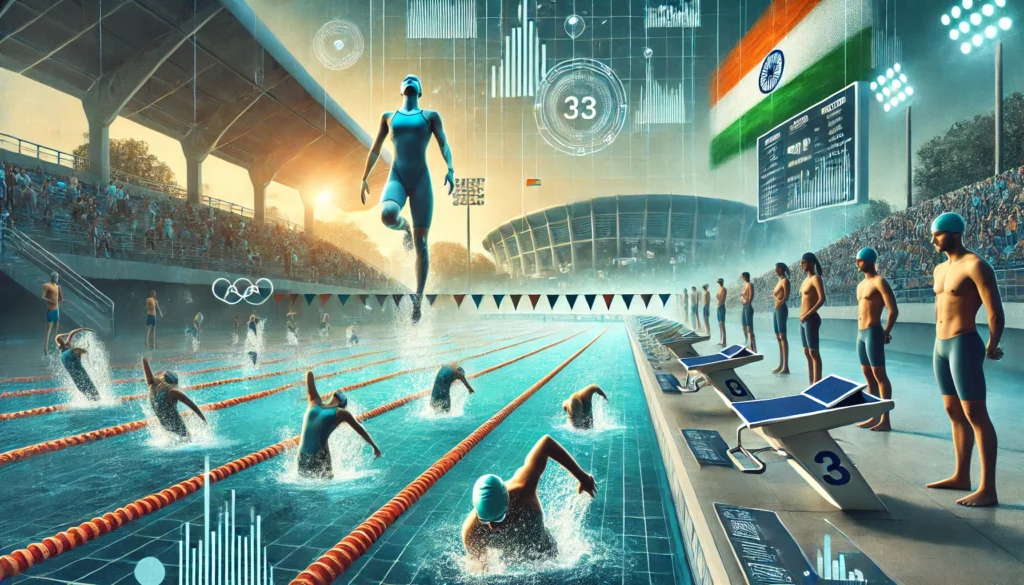
Swimming is gaining momentum as a competitive sport in India, with more young athletes taking up the sport and striving for excellence on national and international stages. Historically, swimming in India has not received the same level of attention or investment as other sports like cricket or badminton. However, recent years have seen a shift in focus, with greater emphasis on developing infrastructure, providing training opportunities, and recognizing emerging talent. This shift comes at a time when the global swimming community has grown significantly, and India has begun to recognize the potential of its swimmers to make a mark on the world stage. The future of competitive swimming in India depends on overcoming challenges such as limited facilities, building a stronger support system for athletes, and ensuring that talented swimmers receive the resources they need to succeed. With the right investments and strategic support, India could become a formidable presence in the world of competitive swimming.
Key Challenges Facing Competitive Swimming in India
Despite the growing interest in swimming as a competitive sport, India faces several challenges that can hinder the development of its swimming talent. These obstacles need to be addressed to ensure that the sport can reach its full potential and that Indian swimmers can compete on an equal footing with their international counterparts.
Infrastructure and Facilities
One of the primary challenges is the lack of adequate infrastructure and facilities. Many regions in India still lack proper swimming pools that meet international standards. Access to Olympic-sized pools and advanced training facilities is limited to a few metropolitan areas, making it difficult for talented swimmers from smaller towns and rural areas to receive high-quality training. Additionally, the maintenance of existing pools is often neglected, leading to poor conditions that can deter new swimmers from taking up the sport.
Access to Coaching and Training
A significant barrier for aspiring swimmers is the limited availability of experienced coaches who can provide specialized training. While there are some qualified coaches in India, their numbers are insufficient to meet the growing demand. This shortage is especially acute in regions outside the major cities, where access to top-tier coaching is scarce. Without proper guidance and training, many promising swimmers struggle to develop the skills and techniques necessary to compete at higher levels.
Financial Barriers for Aspiring Swimmers
Swimming can be an expensive sport, with costs related to training, equipment, travel, and participation in competitions. Many families in India may find it difficult to afford these expenses, especially when the financial rewards of swimming are not as immediate or visible as in other sports like cricket. The lack of sufficient sponsorship opportunities and financial aid further limits the ability of talented athletes to pursue their dreams, forcing some to abandon the sport prematurely.
These challenges collectively create barriers that can limit the progress of competitive swimming in India. Addressing these issues will be critical to ensuring that Indian swimmers have the support they need to succeed at the highest levels and that the sport can continue to grow in popularity.
Government Initiatives and Support for Swimming
In recent years, the Indian government has taken steps to support the development of swimming through various programs and initiatives. Recognizing the need for nurturing athletic talent across diverse sports, the government has implemented policies aimed at providing better training facilities, financial aid, and opportunities for young swimmers to compete.
- Khelo India Program: One of the most impactful initiatives is the Khelo India program, which aims to strengthen the sports ecosystem at the grassroots level. The program focuses on identifying talent in various sports, including swimming, and providing them with the necessary support to train and compete. Under Khelo India, young swimmers have access to specialized training camps, competitive events, and scholarships that help them pursue their passion without the burden of financial constraints. The program has been instrumental in bringing attention to swimming as a viable sport for young athletes.
- National Swimming Camps and Academies: The Sports Authority of India (SAI) has established national training camps and swimming academies to support athletes preparing for major competitions, including the Asian Games and the Olympics. These academies provide access to state-of-the-art facilities, experienced coaches, and a structured training environment that helps swimmers improve their skills. National camps also serve as a platform for top swimmers from different regions to train together, fostering a competitive spirit and creating a sense of camaraderie among athletes.
- Scholarships and Financial Aid for Athletes: To further support young athletes, the government offers scholarships and financial aid programs that aim to cover the costs of training, equipment, and travel. Programs like the National Sports Development Fund (NSDF) and the Target Olympic Podium Scheme (TOPS) provide funding to promising swimmers who demonstrate potential to compete at international levels. This financial support helps to alleviate some of the economic burdens faced by athletes and their families, allowing them to focus on their training and development.
These government initiatives have played a crucial role in raising the profile of swimming in India and providing a foundation for future growth. By continuing to invest in such programs, the government can ensure that more young swimmers have the opportunity to realize their potential and represent India on the global stage.
Top 5 Rising Stars of Indian Swimming
India has seen the emergence of several talented young swimmers who have made their mark in national and international competitions. These rising stars represent the future of Indian swimming, showcasing the potential that exists within the country. Here are five swimmers to watch in the coming years:
- Srihari Nataraj
A standout in backstroke events, Srihari Nataraj has consistently broken national records and has become a prominent figure in Indian swimming. He qualified for the Tokyo Olympics, marking a significant achievement in his young career and raising hopes for future international success. - Kushagra Rawat
Kushagra Rawat is a distance freestyle swimmer who has made a name for himself in events like the 400m, 800m, and 1500m freestyle. His dedication to rigorous training and his ability to compete at high levels have positioned him as a key competitor in the Indian swimming scene. - Maana Patel
One of India’s leading female backstroke swimmers, Maana Patel has represented India in several international events, including the Youth Olympics. Her commitment to the sport and her success in breaking records have made her an inspiration for young female swimmers across the country. - Advait Page
Advait Page specializes in long-distance freestyle events and has shown promise in various national and international meets. His ability to perform well in endurance races makes him a strong contender for future Asian and Commonwealth Games. - Kenisha Gupta
Kenisha Gupta is known for her versatility across different strokes and distances. She has won multiple medals in national championships and is considered one of the rising talents in women’s swimming. Her adaptability and competitive spirit make her a swimmer to watch in the coming years.
These athletes represent the new wave of Indian swimmers who have the potential to achieve greatness on the global stage. Their dedication, combined with the right support and opportunities, could help put Indian swimming on the map.
The Role of Private Organizations and Sponsorship in Developing Swimming
The development of competitive swimming in India is not solely reliant on government support. Private organizations, swim clubs, and corporate sponsorships play a crucial role in creating a conducive environment for young swimmers to thrive. Their involvement has become increasingly important in providing access to resources and opportunities that can elevate the sport to the next level.
Private Swim Clubs and Academies
Private swim clubs and academies have been instrumental in offering specialized training programs to aspiring swimmers. These institutions often provide access to well-maintained swimming pools, experienced coaches, and a structured curriculum that focuses on both technique and fitness. By partnering with schools and local communities, private swim clubs help identify and nurture talent from a young age, creating a pipeline of skilled swimmers ready to compete at higher levels. Some academies also offer scholarships, making training more accessible to athletes from diverse backgrounds.
Role of Corporate Sponsorships in Athlete Development
Corporate sponsorships are vital for providing financial support to swimmers, enabling them to afford the costs associated with training, travel, and participation in international competitions. Brands that sponsor athletes often gain visibility in the sports community, creating a win-win situation where swimmers receive the funds they need, and companies build a positive image through their support of sports. Sponsorships also help raise the profile of the sport, attracting more media attention and creating a larger fanbase for swimming in India.
The Importance of Media Coverage and Publicity
Media coverage plays a significant role in popularizing sports, and swimming is no exception. Increased media attention on competitive swimming events, both at the national and international levels, can help build a larger audience for the sport. Publicity through television, social media, and online platforms can showcase the achievements of Indian swimmers, inspiring the next generation to take up the sport. Media visibility also helps in attracting more sponsors, as brands are more likely to invest in sports that have a substantial following.
Together, private organizations, sponsors, and media outlets form an essential support system that complements the efforts of the government, making competitive swimming a more viable career option for young athletes in India.
Building a Stronger Swimming Culture in India
Creating a stronger swimming culture in India requires a multi-faceted approach that emphasizes education, accessibility, and community involvement. To make swimming a mainstream sport, it is important to start by introducing the sport at the school level, ensuring that children have the opportunity to learn swimming from a young age. Schools and community centers can partner with local swim clubs to offer swimming lessons, encouraging more participation and helping to identify talent early on.
Accessibility to quality training facilities is also key to building a swimming culture. Investments in building and maintaining public swimming pools can provide young athletes with a place to practice without the burden of high membership fees. Creating regional swimming competitions can also help build excitement around the sport and give young swimmers a platform to showcase their skills.
Community involvement is equally important in fostering a love for swimming. Parents and community leaders can play a role by supporting local swim meets, celebrating achievements, and encouraging children to pursue their passion for swimming. By building a community that values the sport, India can create an environment where swimming is seen as a path to personal growth, health, and potential professional success.
A strong swimming culture will not only produce better athletes but also promote the values of discipline, perseverance, and teamwork. By focusing on these areas, India can ensure that swimming becomes an integral part of the nation’s sporting landscape, inspiring more young people to dive into the sport and achieve their dreams.



